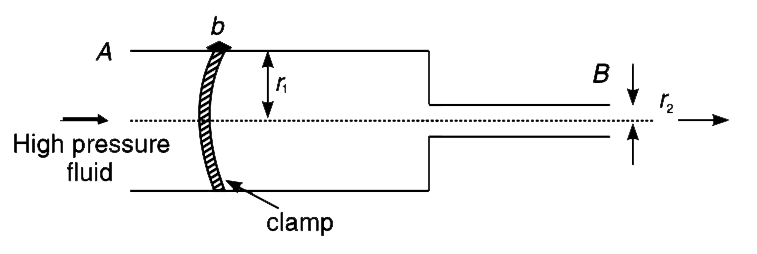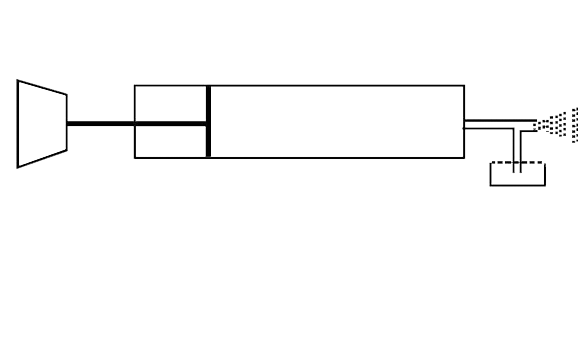In a machine, a fluid from a compressor, which is at high pressure, is allowed to pass through a nozzle. Cross section of the nozzle is shown in the fiuge. The nozzle consists of two sections of radii r1 and r2. The nozzle is fixed on a stand with the help of a clamp. the clamp is a circular ring of radius r1 and width b. The fluid from the compressor is at a presssure of n times the atmospheric pressure p0. assume that the entrie system is horizontal the fluid is ideal and the flow is steady.

(a) what should be the volume flow rate so that pressure of the fluid at end B reduces to half of its value at end A?
(b) If the entire system is kept in gravity free space and the net force on the nozzle due to the fluid flow is F then determine the minimum radial pressure that should be applied on the clamp. so the nozzle remains in place. Coefficient of friction betwwen clamp and nozzle is μ.
(c) If a small hole is punched anywhere on the thinner part of the nozzle (close to end B) what should be the volume flow rate of the fluid so that it does not gush out?
The correct Answer is:(a) Q=πr21r21√nP0ρ(r41−r42)
(b) F2πμr1b
(c) Q=πr21r22
⎷2(n−1)P0ρ(r41−r42)
Step by step video, text & image solution for In a machine, a fluid from a compressor, which is at high pressure, is allowed to pass through a nozzle. Cross section of the nozzle is shown in the fiuge. The nozzle consists of two sections of radii r_(1) and r_(2). The nozzle is fixed on a stand with the help of a clamp. the clamp is a circular ring of radius r_(1) and width b. The fluid from the compressor is at a presssure of n times the atmospheric pressure p_(0). assume that the entrie system is horizontal the fluid is ideal and the flow is steady. (a) what should be the volume flow rate so that pressure of the fluid at end B reduces to half of its value at end A? (b) If the entire system is kept in gravity free space and the net force on the nozzle due to the fluid flow is F then determine the minimum radial pressure that should be applied on the clamp. so the nozzle remains in place. Coefficient of friction betwwen clamp and nozzle is mu. (c) If a small hole is punched anywhere on the thinner part of the nozzle (close to end B) what should be the volume flow rate of the fluid so that it does not gush out? by Physics experts to help you in doubts & scoring excellent marks in Class 11 exams.
Updated on:21/07/2023Topper's Solved these Questions
Similar Questions
An adiabatic cylinder of cross section A is fitted with a mass less conducting piston of thickness d and thermal conductivity K. Initially, a monatomic gas at temperature T0 and pressure P0 occupies a volume V0 in the cylinder. The atmospheric pressure is P0 and the atmospheric temperature is T1(>T0). Find
(a) the temperature of the gas as a function of time
(b) the height raised by the piston as a function of time.
Neglect friction and heat capacities of the container and the piston.
View SolutionTwo lead balls of mass m and 2 m are placed at a separation d. A third ball of mass m is placed at an unknown location on the line joining the first two balls such that the net gravitational force experienced by the first ball is 6Gm2d2 . What is the location of the third ball?
View SolutionA spray gun is shown in the figure where a piston pushes air out of a nozzle. A thin tube of uniform cross section is connected to the nozzle. The other end of the tube is in a small liquid container. As the piston pushes air through the nozzle, the liquid from the container rises into the nozzle and is sprayed out. For the spray gun shown, the radii of the piston and the nozzle are 20mm and 1mm respectively. The upper end of the container is open to the atmosphere. If the piston is pushed at a speed of 5mms^-1 , the air comes out of the nozzle with a speed of
View SolutionA spray gun is shown in the figure where a piston pushes air out of a nozzle. A thin tube of uniform cross section is connected to the nozzle. The other end of the tube is in a small liquid container. As the piston pushes air through the nozzle, the liquid from the container rises into the nozzle and is sprayed out. For the spray gun shown, the radii of the piston and the nozzle are 20mm and 1mm respectively. The upper end of the container is open to the atmosphere.

If the density of air is ρa, and that of the liquid ρl, then for a given piston speed the rate (volume per unit time) at which the liquid is sprayed will be proportional to
View SolutionA gardener holds a pipe of inside cross-sectional area 3.60 cm^(2) at a height of 1.50 m from ground. The opening at the nozzle of pipe has cross-sectional area 0.250 cm^(2) . Water velocity in the segment of the hose that lies on the ground is 50.0 cm//s . a. What is the velocity of water leaving the nozzle? b. What is the thrust force experienced by the gardener due to flow of water through nozzle. c. What is the water pressure in the hose on the ground?
View SolutionA water tank has a small hole in its wall and a tapering nozzle has been fitted into the hole (figure). The diameter of the nozzle at the exit is d_(0)=1cm . The height of water in the tank above the central line of the nozzle is h=2.0m. Calculate the dischargerate in m^(3)s^(-1) through the nozzle. Another nozzle which is diverging outwards is fitted smoothly to the first nozzle. The pressure at the neck of the two nozzle (where diameter is d_(0) ) drops ot 2.5m of water. Calculate the exit diameter (d) of the nozzle. Atmosphere pressure =10m of water and g=10ms^(-2)
View Solutionचालनी नलिका बनाने में भाग लेती है
View Solutionनलिका अन्दर नलिका योजना क्या है ?
View SolutionCatch prey with the help of tube fit or nozzles -
View Solutionबीडर की नलिका पाई जाती है |
View SolutionWater flows at the rate of 2ms-1 through a pipe of radius 2 cm and emerges from a nozzle of radius 1 cry. If the nozzle is directed vertically upwards, water rises to a maximum height of (g=10ms−1)
View SolutionWater flows at the rate of 2ms^(-1) through a pipe of radius 2 cm and emerges from a nozzle of radius 1 cm. If the nozzle is directed vertically upwards, water rises to a maximum height of ( g= 10 ms^(-2))
View SolutionWater flows at the rate of 2ms−1 through a pipe of radius 2 cm and emerges from a nozzle of radius 1 cm. If the nozzle is directed vertically upwards, water rises to a maximum height of (g=10ms−2)
View Solutionहेवरशियन नलिका रखती है
View SolutionThe steam temperature in a boiler is 600^@C , the pressure is 200 atm. The steam is ejected from a Laval nozzle. Find the velocity and the temperature of steam in the critical cross section. To avoid the condonsation of steam as it leaves the nozzle, its temperature should exceed 100^@C . What is the maximum speed at which the steam leaves the nozzle?
View Solution
